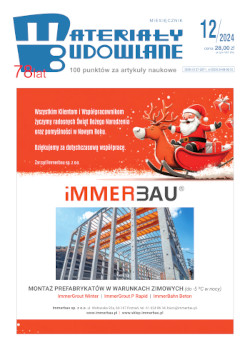Zastosowanie komputerowej analizy obrazu do oceny porowatości powierzchni betonu architektonicznego
Open Access (Artykuł w pliku PDF)
citation/cytuj: Benedysiuk T., Jackiewicz-Rek W., Garbacz A. The application of computer image analysis for assessment of surface porosity of architectural concrete. Materiały Budowlane. 2024. Volume 626. Issue 10. Pages 29-39. DOI: 10.15199/33.2024.10.04
M.Sc. Eng. Tomasz Benedysiuk, Warsaw University of Technology, Faculty of Civil Engineering
ORCID: 0000-0002-8870-0225
Dr. Eng. Wioletta Jackiewicz-Rek, Warsaw University of Technology, Faculty of Civil Engineering
ORCID: 0000-0001-6056-5458
Prof. Eng. Andrzej Garbacz, Warsaw University of Technology, Faculty of Civil Engineering
ORCID: 0000-0002-5229-7884
Correspondence address: Ten adres pocztowy jest chroniony przed spamowaniem. Aby go zobaczyć, konieczne jest włączenie w przeglądarce obsługi JavaScript.
DOI: 10.15199/33.2024.10.04
Original research paper / Oryginalny artykuł naukowy
Abstract. This article presents the results of research on an innovative method for assessing the porosity of architectural concrete surfaces using image analysis techniques. The method utilizes local thresholding algorithms and morphological operations to minimize the influence of surface color and roughness on themeasurement results. The use ofmodel samples with controlled color and surface topography allowed for verification of the method's accuracy in assessing surface porosity and its applicability for evaluating the surface quality of smooth architectural concrete.
Keywords: architectural concrete; concrete porosity; image analysis; thresholding algorithms; morphological operations.
Streszczenie. W artykule przedstawiono wyniki badań nad innowacyjną metodą oceny porowatości powierzchni betonu architektonicznego z zastosowaniem technik analizy obrazu. Metoda wykorzystuje algorytmy progowania lokalnego i operacje morfologiczne w celu minimalizacji wpływu koloru i chropowatości powierzchni na wynik pomiaru. Zastosowanie próbek modelowych, o kontrolowanych parametrach kolorystyki i struktury geometrycznej powierzchni, pozwoliło na przeprowadzenie weryfikacji dokładności metody oceny porowatości powierzchni i możliwości jej zastosowania do badania jakości powierzchni gładkiego betonu architektonicznego.
Słowa kluczowe: beton architektoniczny; porowatość betonu; analiza obrazu; algorytmy progowania; operacje morfologiczne.
Literature
[1] Jackiewicz-Rek W. Kształtowanie jakości gładkiego betonu architektonicznego. Materiały Budowlane. 2015; 24 – 25.
[2] PTV 21-601 Elements Architectoniques et Industriels Prefabriques en Beton Decoratif. 2001.
[3] AFNOR. Normes P18-503 Surfaces et parements de béton – Eléments d’identifications. 1989.
[4] ÖNORM B 2211 Beton-, Stahlbeton- und Spannbetonarbeiten – Werkvertragsnorm. 2009.
[5] LST 2015:2020 Surenkamieji betoniniai gaminiai. Paviršiaus išvaizdos charakteristikos ir jų tikrinimo metodai. 2020.
[6] ДСТУБВ. 2.6-2:2009 ВИРОБИ БЕТОННІ І ЗАЛІЗОБЕТОННІ Загальні технічні умови. 2009.
[7] CIB ReportNo.24 Concrete Surface Finishings – Tolerances on Blemishes of Concrete. 1973.
[8] Deutscher Beton- und Bautechnik-Verein E.V. Sichtbeton. Exposed Concrete. 2008.
[9] ACI 347.3R-13 Guide to Formed Concrete Surfaces. 2013.
[10] Kuniczuk K. Beton architektoniczny. Wytyczne techniczne. Polski Cement; 2011.
[11] Malisch W, Brown H. Examination and Evaluation of ACI 347.3R-13 Guide to Formed Concrete Surfaces. ACI Foundation; 2017.
[12] Kwasny J, SonebiM, Plasse J,Amziane S. Influence of rheology on the quality of surface finish of cement-based mortars. Constr BuildMater. 2015; 89: 102–109.
[13] Lemaire G, Escadeillas G, Ringot E. Evaluating concrete surfaces using an image analysis process. Constr Build Mater. 2005; 19: 604 – 611.
[14] Lee BY, Kim J, KimYY, Yi ST.Atechnique based on image processing formeasuring cracks in the surface of concrete structures. SMiRT 19, Toronto; 2007.
[15] Liu B, Yang T. Image analysis for detection of bugholes on concrete surface. Constr Build Mater. 2017; 137: 432 – 440.
[16] Hoang ND, Nguyen QL. A novel approach for automatic detection of concrete surface voids using image texture analysis and history-based adaptive differential evolution optimized support vector machine.Advances in Civil Engineering. 2020; Article ID 4190682.
[17] Yoshitake I, Maeda T, Hieda M. Image analysis for the detection and quantification of concrete bugholes in a tunnel lining. Case Stud. Constr. Mater. 2018; 8:116 – 130.
[18]Wei F,YaoG,YangY, SunY. Instance-level recognition and quantification for concrete surface bughole based on deep learning.AutomConstr. 2019; 107.
[19] da Silva WRL, Štemberk P. Expert system applied for classifying selfcompacting concrete surface finish. Adv Eng Softw. 2013; 64: 47 – 61.
[20] Liu Y, Cho S, Spencer B, Fan J. Automated assessment of cracks on concrete surfaces using adaptive digital image processing. Smart Struct Syst. 2014; 14: 719 – 741.
[21] Niblack W. An introduction to digital image processing. Prentice-Hall, Englewood Cliffs, NJ. 1986. pp. 115 – 116.
[22] Sauvola J, Seppanen T,Haapakoski S, PietikainenM.Adaptive document thresholding. Proc. 4th Int. Conf. on Document Analysis and Recognition, Ulm, Germany. 1997. pp. 147 – 152.
[23] Khairun S,MunadiK,AwayY,Arnia F. Improvement of binarization performance using local otsu thresholding. International Journal of Electrical and Computer Engineering (IJECE). 2018.
[24] Bernsen J, Dynamic thresholding of grey-level images. Proc. of the 8th Int. Conf. on Pattern Recognition. 1986.
[25] Feng M-L, Tan Y-P. Contrast adaptive thresholding of low quality document images. IEICE Electron. Express. 2004;1(16): 501 – 506.
[26] Singh O I, SinamT, James O, Singh T R. Local contrast and mean based thresholding technique in image binarization. International Journal of Computer Applications. 2012; 51: 5 – 10.
[27] Parker JR. Algorithms for image processing and computer vision. John Wiley & Sons. 2010.
[28] Bradley D, Roth G. Adaptive thresholding using the integral image. Journal of Graphics Tools. 2007; 12(2): 13 – 21.
Received: 21.08.2024 / Artykuł wpłynął do redakcji: 21.08.2024 r.
Reviced: 09.09.2024 / Otrzymano poprawiony po recenzjach: 09.09.2024 r.
Published: 22.10.2024 / Opublikowano: 22.10.2024 r.
Materiały Budowlane 10/2024, strona 29-39 (spis treści >>)




























